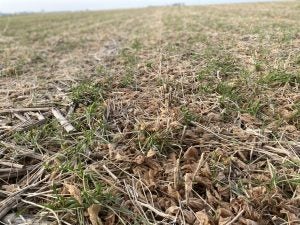There is currently a great deal of interest in the transfer of carbon from the atmosphere back into the soil. Farmers are beginning to look at carbon markets, just as they look at crop markets, to improve their bottom line.
Because of the increased interest in moving carbon into the soil via the plants grown on farms and ranches, there are a lot of explanations about how that happens. Most of the explanations state that decomposition of crop residues is one source of carbon that might accumulate in the soil, and that is true, but it is not the primary pathway in which carbon ends up in the soil. There is also much discussion about various conservation practices that should result in a net increase of carbon in the soil. However, it is advisable that one should develop a good understanding of how carbon actually gets into the soil before signing a carbon sequestration contract.
The majority (about 80 percent) of the carbon in the soil has come from the remains of soil microbes, compounds that were produced by soil microbes, or living soil microbes themselves. Of all the carbon in the soil, roughly five times as much comes from soil microbes fed sugars or other substances provided to them by living plant roots compared to the carbon from decomposition of above-ground plant residues.
This is why it is important to have living roots feeding soil organisms as much of the time as possible in an effective carbon-capturing system.

It is the sugars that are exuded by plant roots and the outer layer of cells sloughed off by growing plant roots that feed soil organisms. Up to half of the carbon a plant pulls from the air and converts into its many tissues and other compounds goes below ground to grow roots and feed soil organisms. The soil organisms then feed the plant the many and varied nutrients those plants need to grow. During this cooperation between plants and soil organisms, the soil organisms don’t respire all the carbon the plants give them as food, some of it becomes more stable carbon compounds in the soil that we eventually include in a measurement of “soil organic matter.”
What does this mean for farmers who wish to use the plants they grow to move carbon from the atmosphere into the soil where it can be measured and generate carbon credits as an additional source of revenue?
We must look at the big picture. No practice(s) will get you additional carbon in the soil without an understanding of how the soil functions as a biological system. Since the capture of carbon from the air into the soil is a biological process that takes place in the soil, our goal must be to make life as good as possible for the soil organisms that will do the work.
This can be accomplished by observing four basic principles: disturbing the soil less, growing a diversity of plants, maintain living roots in the soil as much of the time as possible, and keeping the soil covered at all times.
There is no one practice that will address all four principles. Every time the soil is tilled, carbon goes out of the soil and into the atmosphere. Soil organisms need a diverse diet from a diversity of plants to thrive. Living roots should be maintained in the soil both during, and beyond, the traditional growing season. Soil cover is the roof of the house where soil organisms live.
All four principles must be practiced in concert with each other to achieve the goal of more carbon in the soil.

Consequently, you can’t expect to accumulate carbon in the soil by growing a cover crop if the rest of the system includes any significant amount of tillage, or only includes one or two different crops, or does not keep the soil covered. However, a system that does not till the soil, includes a diversity of species of plants in both the crop rotation and in a cover crop mixture that maintains living roots in the soil outside of the typical growing season, and keeps the soil covered year-round, will likely sequester carbon in the soil.
Do not focus on practices, focus on principles if you wish to be successful in sequestering carbon in the soil!
So, if you are interested in getting paid to store carbon in the soil, it is important to understand how your management system might do that. Without understanding how carbon accumulates in the soil, you may not accumulate any carbon after applying a practice or two that did not necessarily create the favorable environment in the soil for soil organisms to make it happen. While plant residues on the soil surface are a necessary part of making life good for soil organisms, the residue on the soil surface does not contribute most of the carbon that stays in the soil.
Only a complete understanding of how soil and plants interact as a biological system will result in successful carbon sequestration and profitable crop production.
References
Cole, D. Gross and Robert B. Harrison. The Case for Digging Deeper: Soil Organic Carbon Storage, Dynamics, and Controls in Our Changing World. Soil Syst. 2019, 3, 28. www.mdpi.com/journal/soilsystems.
Liang, C.; Balser, T.C. Microbial production of recalcitrant organic matter in global soils: Implications for productivity and climate policy. Nat. Rev. Microbiol. 2010, 9, 75.
Jon Stika is a retired Natural Resources Conservation Service soil health instructor and current part-time professional at the North Dakota State University Dickinson Research Extension Center. He is also the author of “A Soil Owner’s Manual: How to Restore and Maintain Soil Health.”



